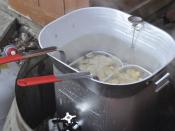Osmosis Investigation
Aims and Objectives
To determine the effect that varying salt concentration, in a solution, has upon the osmotic ability of potato chips of a given size.
Scientific Background Knowledge
Put simply osmosis is defined as the net movement of water molecules, across a selectively permeable membrane, from a dilute to a concentrated solution.
It is a special form of diffusion because it can only involve water molecules. However, it is not an isolated laboratory process. Many cell membranes behave as semi/selectively permeable membranes, and osmosis is a vital to their functioning. For example, osmosis is the key mechanism involved in the transportation of fluids in living organisms, such as a plant's root cells. Without the process of osmosis the transport of water from the soil to the roots in plants would not be able to take place.
However, it is able to do so as the water can move through the plant cell's semi permeable membrane which separates the two solutions of different concentrations.
Specifically in this example, water is able to diffuse into the vacuole of the plant's roots cells, because there is effectively a lower concentration of water in the cell sap, than there is outside the cell in the soil.
As a result this then causes the contents of the cell to push out and expand. This result of this process is known as plasmolysis, whereby the potato cannot expand and take in any more water.
At this point, when the cell stops swelling, it is said to be turgid. This turgidity is very important to the plant as this is what causes it to stand strong and upright.
In contrast, a plant is said to be flaccid when its cells shrink and contain very little water. This can occur when plant cells are...


